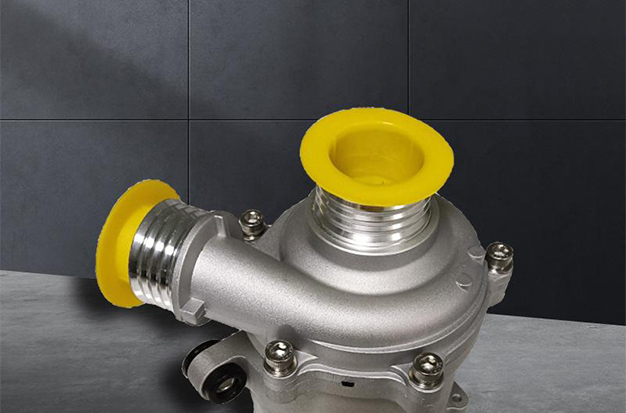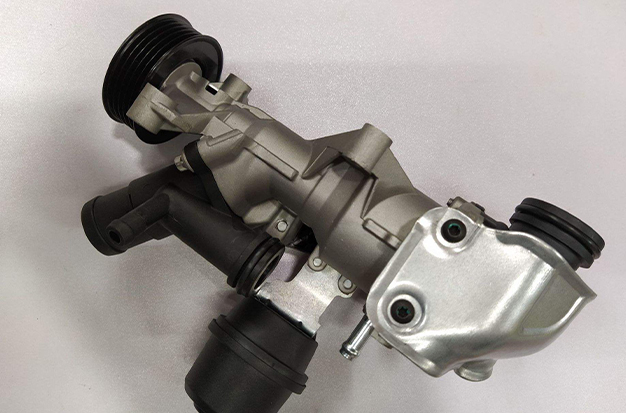
How To Repair The Water Pump?
Replacing a critical component of your car’s cooling system is referred to as “repairing a water pump.” In terms of auto repairs, it’s one of the simplest tasks to complete, so pretty much anyone who can use a wrench can do it by themselves. To fix a water pump, follow these instructions.
How Does A Water Pump Work?
In order to remove enough heat to keep the engine from overheating, the water pump makes sure that enough coolant liquid is flowing around the cooling system and engine. The pump will circulate more frequently to deal with the higher levels of heat produced as the engine works harder when the load on it is higher.
A bladed impeller inside the pump forces coolant through the pump and out toward the engine. This impeller could be made of plastic or metal. The impeller is then mounted on a shaft, supported by a seal assembly that enables it to function without any hindrance.
The pump uses centrifugal force to circulate the coolant; a belt that is fastened to the pump and crankshaft keeps the pump turning. The pump is crucial in ensuring that coolant gets to the right places because if the engine overheats, it could completely malfunction and be very expensive to repair. After passing through the engine, the coolant travels to the radiator to cool off before going back to the pump for another circulation.
What Signs Point To A Failed Water Pump?
There are several signs of a bad water pump:
- You might not notice that the engine is overheating until the warning light illuminates. A general idea of what the operating temperature should be might help, but only if it can be easily measured
- By way of the weep holes on the casing, coolant may be dripping around the water pump. There will be a puddle on the floor when the car has stood in the same position for a few hours – all you have to do then is follow the leak to its source
- When the engine is running, the water pump might be noisier than usual (although you’ll need to know how much noise that normally entails). The source of the louder noise will probably come from a defective impeller or an impeller that is coming away from its shaft, in which case it will have to be replaced

How Come Water Pumps Break Down?
There will always be some water pumps that suddenly stop working for a variety of reasons, necessitating repair or replacement. One major problem that may arise and that K-Seal is able to resolve is a leak in the casing. This enables coolant to escape, preventing it from cooling the engine’s temperature by circulating through it.
A water pump seal may start to leak for the following reasons:
High Temperatures
The polished rubber seal’s surface will eventually give way to the high temperatures that the ignition of the car exposes it to. The coolant will then leak out through tiny cracks or holes that will eventually form.
Electrolysis
Regular flush-and-fills are advised because corrosive inhibitors in seal plating lose their effectiveness over time and coolant becomes more abrasive as it is used. The seal face experiences electrolysis as the inhibitors degrade and the coolant becomes more abrasive, allowing coolant to seep through.
Abrasive Particles
When tap water is combined with antifreeze to make coolant, there is a chance that tiny abrasive particles will enter the pump and harm the seal (this is why you should only use soft, distilled water if making coolant yourself).
What Is The Cost Of Repairing A Water Pump?
According to a number of variables, including the garage you go to and the vehicle you drive, the cost of replacing a water pump can vary significantly. Although the price of a water pump will typically range from $50 to $75, the cost of labor will increase the final price you pay. Changing a water pump can cost up to $500 in some cases. To ensure you’re getting the best deal, it’s crucial to request quotes from a number of different local mechanics.
How To Repair The Water Pump?
- This applies to fan-operated cooling systems. Verify the water pump isn’t working by testing the bearings by manually jolting the fan blade. If it doesn’t require repair, the fan bearing should stay firmly in place.
- When using a motorized fan, jiggle the pulley that drives the pump. If it’s functioning properly, the shaft should remain tight.
- Look for splotches on the pump casing that would be the result of excessive fluid leakage and point to a bad seal. Over time, a few drops of water should sweat from the vent hole, but a broken seal will result in excessive overflow.
- As soon as it is confirmed that the water pump is malfunctioning, disconnect the negative battery line. Remove the radiator cap, then release the valve under the front passenger’s side to empty the radiator.
- If there is a fan belt, remove it. Radiator hoses should be uncoupled.
- On the shaft of the water pump, unbolt the fan shroud. Dispatch the fan shroud. The fan should be moved by removing the bolts.
- Drive pulley removal requires releasing the bolts holding it in place. The broken water pump should be removed by loosening its bolts.
- Scrub the area around the gaskets to remove any dirt and debris.
- Apply industrial cleaning solution to the area, then scrub it clean.
- Follow the sealant for the gaskets manufacturer’s instructions when using a water pump. If instructed, apply gasket sealant. Replace the gaskets by installing them.
- Install the bolts after setting the replacement water pump in place. The drive pulley should be reinstalled. Reinstall the bolts after setting the fan and shroud in place.
- Re-connect the radiator hoses. Using the belt routing diagram provided by the manufacturer, reinstall the fan belt.
- Verify that the radiator valve is shut before adding more water to the radiator. Keep the radiator cap closed. Reattach the negative battery cable.
- Start the vehicle and listen for any unusual noises or leaks.
When Should A Water Pump Be Replaced?
Leaks: A coolant leak is one of the initial symptoms. The bottom of the water pump has a drain (weep) hole. A small amount of dry coolant residue leakage around the drain is average, but coolant leaking from the drain signifies that the pump is out of order and needs to replace. When a water pump is deemed defective and needs to be replaced, the manufacturers of vehicles and spare parts provide instructions for mechanics.
inconsistent temperature sensor readings: The temperature sensor or gauge will always be kept within acceptable ranges by a fully functional cooling system. However, a faulty or wrong water pump can cause the temperature gauge needle to fluctuate from normal to hot and vice versa.
Noises: An intermittent rattling or grinding sound, caused by a malfunctioning water pump, may be heard in some cars or vehicles. In such cases, the mechanic will need to identify the noise source before shutting off the water pump. For example, a mechanic might discover that the water pump shaft is loose, which indicates that the pump is broken.
Too-high a coolant temperature: Overheating of the engine is the most obvious sign of a bad water pump. This is usually indicated by the engine temperature warning light (or wavy line icon) or elevated engine temperature signals on the dashboard.
How Do You Replace A Water Pump Car?
Before carrying out the water pump car replacement, be sure to check the vehicle manufacturer’s recommendations before replacing any water pump. Follow all specific instructions as each motor design may have a different belt drive system configuration. To replace your car’s water pump, just follow these easy steps.
- Start with a completely cooled engine, then disconnect the negative terminal of the battery.
- Drain the coolant into the sump by loosening the tap at the bottom of the radiator.
- Replacement pumps are usually supplied with gaskets required for operation. Before beginning work, consult your repair manual and familiarize yourself with the location and kind of the pump.
- The water pump is sometimes well hidden under the exhaust manifold. You can access the water pump by removing the parts listed in your vehicle’s repair manual. On some engines, accessing the water pump may require removing the radiator, hoses, and shroud. The harmonic balancer, pulleys, and fans may also need to be taken apart, which calls for a specialized puller.
- Remove the old water pump. When removing, be mindful of the bolt lengths as they might not be uniform.
- Before reassembling, make sure all is clean and free of old gasket material and water pump glue. Coolant leaks could happen if the mating surfaces are dirty.
- Check the water pump installation and visualize the assembly before proceeding.
- Use silicone RTV water pump gasket if recommended in the repair manual. Spend some time on this step because rushing it can result in leaks. Carefully prepare the veneer surface first by using a putty knife or gasket scraper. You don’t want a poorly installed gasket that requires a redo to fix any leaks.
- Install a new pump. For the proper reinstallation procedure, consult your manufacturer’s manual. To specifications, tighten each bolt.
- Any components you’ve taken out should be put back in. To fill the coolant and coolant mixture correctly, refer to your manufacturer’s manual. In order to prevent malfunction and overheating, make sure to vent the system.
Conclusion
Even though your water pump might be the cause of your engine problems, it’s possible that there are other parts you should also check. Explore your engine and the crucial parts that keep everything running smoothly by clicking on an engine part in the interactive diagram below.


Average Rating